Article Type: Review
Article Date: February 01, 2010

P-51D Mustang Product Info
Product Name: P-51D MustangCategory: Flight Simulator (Add On for FSX)
Developer: Aeroplane Heaven
Publisher: Flight 1 Software
Release Date: January 15, 2009
System Spec:
- OS: Windows XP or Vista
- Processor: 2.8 GHz
- Memory: 2 Gb RAM
- Hard Drive: 433MB
- Video Card: 256MB
by Michael "Stansdds" Stansfield
There is a tremendous variety of freeware and payware add on aircraft for FS9, but FSX seems to have been slow in obtaining such a variety of add ons. Most of us have had to settle for FS9 aircraft that have been ported over to make them more or less compatible with FSX. One of the aircraft that is in abundance for FS9, but very few are available for FSX is the P-51 Mustang. Flight1 Software and Aeroplane Heaven have released a P-51D built specifically for FSX. Their aircraft is designed for FSX only, it is not a port over and is fully compatible with Service Pack1, Service Pack2 and Acceleration.
Inside the CD case you will find the CD as well as something that is often missing from software today and that is printed materials. No, they are not big, but it is a nice touch. The first document is a reprint of an article from FlyPast magazine detailing the history of one particular P-51D, its loss in combat and photos of its recovery and restoration. The second document is a condensed version of a P-51D/K pilot's manual. Like I said, this is a nice touch and is better than having to print out a manual or pull up a computer document. Installation of the software was easy.
 |
The P-51D from Aeroplane Heaven and Flight1 |
We will begin our review of this aircraft with a walk around of the exterior. From the outside it looks like a P-51D, especially from the side. The canopy and windscreen feature a bit more tint than you would find on any wartime P-51 or most restored Mustangs today, but not as dark as a few of the P-51's that were restored in the 1970's or 80's, some of which had heavily tinted canopies. One glaring error is the fillet joining the leading edge of the wing to the fuselage. Real P-51D's had a small radius fillet at the leading edge, this model has a large and very obvious radius to that fillet. The exhaust stacks also appear to be undersized when compared to photos of real P-51's. Also worth noting is the rear view mirror. Even though some of the models have one or two mirrors mounted to the top of the windscreen, they are not present in the view from the cockpit... oops!
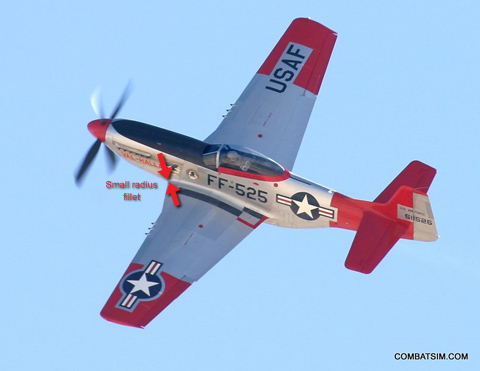 |
A real P-51D, note the aluminum finish and the small radius fillet at the leading edge of the wing.1  |
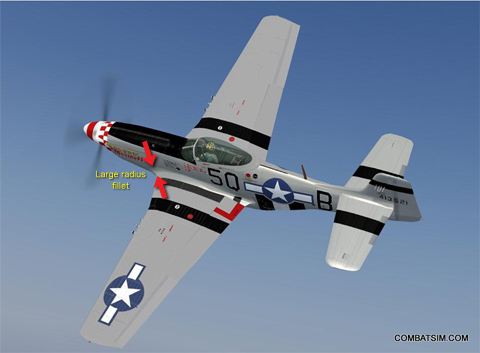 |
The Flight1 P-51D, note the large radius fillet and the gray paint appearance of the aluminum finish. |
This aircraft comes in two flavors, the P-51D-10 and the P-51D-30, each with several paint schemes, some have propellers with cuffs, some have props without cuffs. From the factory, all P-51D's used Hamilton Standard propellers with cuffed blades. It was the P-51K, a P-51D built at the Dallas, Texas facility that used an Aeroproducts propeller that did not have cuffs. You will find restored P-51D's with cuffed props and some with cuffless props. From the cockpit you will see the different props. There are varying degrees of dirt, grime and weathering applied to the paint schemes. Some of the weathering looks too heavy, on other paints the weathering looks nice. The natural mental finishes are not polished or shiny, but appear somewhat dulled and not particularly realistic. The worst is the RNZAF scheme, which is supposedly a completely natural metal finish except for stencils and markings, but the aluminum looks more like a uniform coat of gray paint. All skins feature a "NO STEP" stencil on the wings that is over sized and in a font that is not correct for a factory P-51 nor most restorations. The British camouflage scheme paint lacks this stencil on one wing and the hinge area of one of its flaps appears to be unpainted. The wheels look nice, but the side that faces the landing gear strut should have 10 large holes near its perimeter, not 16 rectangular slots. Control surfaces are animated and there are a couple of keyboard commands that allow an engine access panel to be removed and the starboard machine gun and ammunition bays to open. The animated panels are nice, but they don't make up for the model inaccuracies, at least in my opinion.
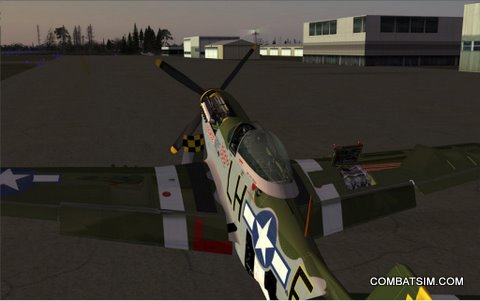 |
Animated panels are nice. |
There are options for external ordnance including 5 inch HVAR's, bombs, drop tanks and bazooka launching tubes. The external ordnance looks ok, but the bazooka tubes appear to be far too large in diameter and the drop tanks are oddly shaped. In fact, the drop tanks appear to be shaped like those found on the North American F-82 Twin Mustang.
Let's step into the cockpit and see what that's like, after all, a pilot spends his or her flight time inside the cockpit. It's nice, well detailed, completely devoid of any weathering or wear. Hmmm, the outside is weathered, but the cockpit is absolutely pristine, an interesting mix of two worlds. All of the controls are present and work, including the canopy emergency release and don't pull it unless you mean it! There is a K-14 gun sight, turning it on gives you a fixed reticle, but the gryo-fixed switch does nothing, neither do the ranging or wingspan size controls. I can live with that and for me it is better than a permanently "on" reticle. The guns don't fire and you can't drop bombs or launch rockets with this aircraft, so it's all there just for show, but this is FSX and not a combat flight sim. Missing is the rear radar warning light. Most P-51D's were factory equipped with a simple radar system that illuminated a light mounted on the top left side of the instrument panel if it detected an aircraft approaching from the rear. Ok, so the external model has the radar antenna, but the indicator is not in the cockpit, is this a wartime P-51 or a restored P-51?
The windscreen framing looks odd with all the over sized rivets. P-51D windscreen frames actually have a very clean appearance from inside. The tint of the windscreen and canopy are obvious, yet there is no tint to the bulletproof center panel of the windscreen. In real Mustangs, the plexiglass canopy and windscreen side panels had virtually no tint, but the laminated bulletproof center panel had a slightly green tint. Odd, the developers seemed to have missed the ball yet again. The center bulletproof panel also appears to be too narrow and tapers excessively from top to bottom when compared to cockpit photos and videos of real P-51D's. The canopy also has a haze and a reflection of part of the cockpit interior painted onto the canopy. I find this to be distracting, especially in night flying. There are dynamic reflections as well and they are ok, but the canopy's permanent reflection and haze detract from the flight experience.
 |
A comparison of a real P-51D cockpit and the Flight 1 cockpit.2 |
Flight controls and instruments are present, the instruments are very crisp and easy to read as is most of the stenciling inside the cockpit. On the floor, to the right of the seat, you will find an extra panel that selects any external ordnance that is to be displayed. Here is a tip, when you load this aircraft, the default fuel load is a full center tank (aft of the pilot's seat), full wing tanks and full drop tanks. If you do not select drop tanks from the external load panel in the cockpit, you get to fly on the fuel in those drop tanks, but they will not appear on the aircraft. There is a huge problem in this cockpit and that is the throttle. When the throttle is pushed forward, the throttle handle blocks the pilot's view of the airspeed indicator. Even with Track IR and lots of neck craning, there is no way to see the airspeed indicator. After looking at photos and taking some screen shots, I've come to the conclusion that the throttle may be a bit over sized and the instrument panel is definitely located too far aft of where it would be in a real P-51. The result is the throttle handle nearly touches the instrument panel at full throttle, completely blocking out the airspeed indicator.. Your best bet is to fly this aircraft with the in-game HUD (that unsightly, red lettering at the top of your computer monitor) turned on. Yuck! This is a deal breaker for me.
 |
Cockpit of a real P-51D, note the distance from the throttle quadrant to the instrument panel.3 |
 |
The Flight1 P-51D, note the position of the instrument panel. |
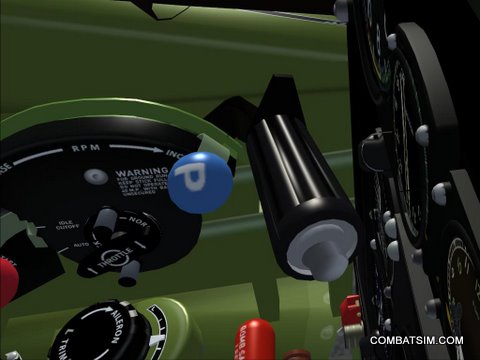 |
How close is the throttle handle to the instrument panel? Bet a pilot could not get his hand in there. |
Ok, so the whole model falls well short of expectations, but how does it fly? The CD case art indicates that this software is "tested and approved by qualified P-51 pilots", hydraulic bleed down for gear doors, accurate start procedures and high fidelity sounds are part of the package. The gear doors and flaps do, indeed, bleed down when the engine is off, so they did get that right. The accurate start procedure centers around priming the engine for no more than 4 seconds, although the engine will start just fine if you do not use the primer or even the electric fuel pump. If you over prime, the engine will start, but you will get a flame effect from the exhaust ports in addition to the smoke. I do like the flame effect, but I'm not convinced the primer switch is correct. Now, I've never sat in a real P-51 cockpit and if I did, odds are I would not be allowed to try the primer switch, but I do know that in other aircraft that use an electric primer pump you will find it is a spring loaded switch. This prevents accidental priming. This aircraft has a standard toggle switch. Be careful, if you happen to click on it after starting you will get flames shooting from your P-51's exhausts. I think the priming switch might be another "oops", but the supercharger switch is definitely a mistake. Real P-51's, and it's in the pilot's manual for the P-51D/K, have a manual switch that in the down position puts the supercharger in "automatic", a center position which puts it in "low" and the upper, "high", position is spring loaded so the pilot can select "low" blower at high altitude for better fuel economy, but the "high" position was only for testing the supercharger. The switch in this P-51 does not have a spring loaded supercharger switch.
 |
Oops, looks like I over primed. Anyone have some marshmallows? |
Ground handling is what I expect from a tail dragger with a high performance engine. Rudder authority during taxiing is quite limited, so differential braking is a must. Don't just jamb the throttle forward and expect to maintain control, the engine and prop torque will steer you to the left and into disaster. I highly recommend holding the brakes until you get about 40 inches of manifold pressure, then release the brakes and slowly advance the throttle, applying rudder as needed. Once the tail comes up you can apply more throttle and take to the air. This seems quite accurate. The P-51D was well known to not be able to perform aerobatics with a significant amount of fuel in the center tank or in the drop tanks, this is also well detailed in the P-51D/K pilot's manual. Unfortunately, this P-51 can make tight turns, dives, steep climbs, rolls and perform loops with these tanks full. The center tank will cause a slight pitch up to the nose and drop tanks will cause a pitch down, and that is correct, but they do not adversely affect any other flight characteristics of this P-51. Getting past the fuel tank issues, it does fly and handle smartly. Acceleration is quick and the aircraft responds nicely to inputs, like it should. Aerobatic performance seems right and it can be a joy to fly so long as you don't look for that airspeed indicator or become distracted by the giant rivets in the windscreen frame or the hazy canopy. Getting out of stalls and spins is not difficult at all and although the P-51 was known for being a good aircraft to fly, recovery in this one seems a little too easy.
In altitude tests I did manage to briefly touch 37,800 feet, which is well shy of the 41,900 foot ceiling stated in most reference books, but that is pretty good and will most of us really want to fly at such high altitudes? A water-methanol injection system is also modeled and works properly. It will only work for a total of 5 minutes, as it was in real P-51's. Another engine management issue I do have is that the engine in this P-51 seems to be indestructible. I tried my best in flight and on the ground to overheat it or otherwise damage it, but I never could. You can fly at full throttle until you run out of fuel without worrying about the engine failing. This is a common short fall with many aircraft in the MicroSoft flight sim series, so I will not fault the developer on this issue, although some developers are offering aircraft with engine failures accurately modeled. This P-51 does tend to float and bounce upon landing, but P-51's can be touchy when it comes to landing. It is a sleek design and just wants to fly.
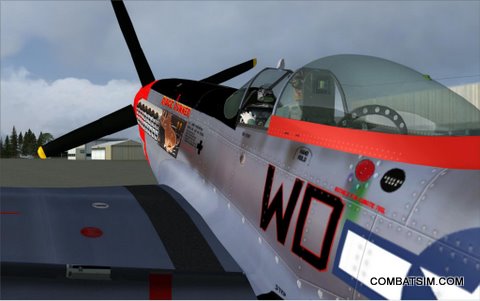 |
Dirty and grimy, note the mirror, it disappears once you are inside the cockpit. |
Dirty and grimy, note the mirror, it disappears once you are inside the cockpit.
The "hi-fi" sound set is just "ok" in my opinion. I have heard better freeware sets. The sounds seem to be a bit muffled and the starter sound has some strange, metallic tones to it and the shutdown sound has a bit of a echo tone. I'm not real impressed, especially since this is not freeware. I would have expected a set of sounds that sound like a real P-51, but then again this P-51 departs from reality in all other areas, so why should the sound set be any different?
So what are my final thoughts? This software falls short of its hype. Numerous errors in the model, a useless airspeed indicator, certain flight dynamics that don't match the real P-51 flight manual, and poor quality sounds, yet this is supposedly "tested and approved by qualified P-51 pilots". If you are desperate for a P-51D that is not a port over from FS9 and are not satisfied with the MicroSoft P-51 Racer that is included with Acceleration, then you don't have a choice at this time. I can only hope that there will be competition in the FSX add on aircraft market that will bring more choices and better software.
Join a forum discussion about this review ...
Photo credits:
- The Flying Kiwi: P-51D in Flight
- Pima Air and Space Museum: P-51D Mustang Restoration
- SimAce: P-51D Cockpit
